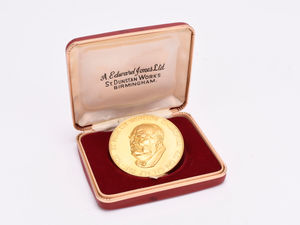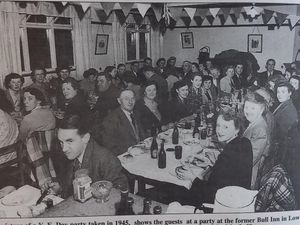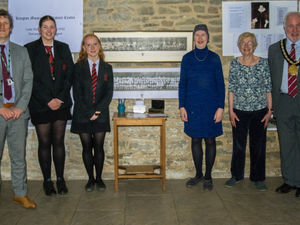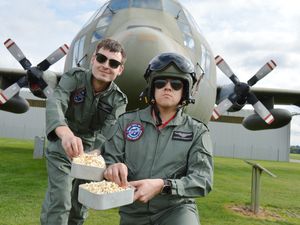Eric's memories of Donnington days
For Eric Jones, pictures we carried of Donnington in the old days were a real trip down memory lane - and as he celebrated his 90th birthday last December, it's quite a journey back to his childhood.

Mr Jones lives these days in Shrewsbury, but came to Donnington as a child from Ruyton-XI-Towns.
In the 80 years since, many of the industrial landmarks of the Donnington in which he grew up have disappeared so completely under roads, roundabouts, and housing, that a modern generation may not realise they ever existed.
So let us join Eric as he takes us on a tour through past times...
"I was 10 years old in 1936 when I first came to Donnington along with my mother who was to keep house for a widower and her son. The family were well known to us and indeed the following year the son became my stepfather," recalls Eric.
"We had travelled from Ruyton-XI -Towns which was on the other side of the world.
"We arrived at Donnington Station at 12.55. I know that because of the works hooter which sounded at that time and again at 1pm to summon the men back to work after dinner break. I had not heard that sound before and for a moment or two I found it scary
"A little way up the road I saw a very small man emerge from a little office opposite to the clock tower which housed the offending hooter. The man had a green and red flag, the red one in his right hand and the green one tucked under his left arm which I learned later was artificial.
"He waved the red flag to halt the traffic although there was not any, but he did bar the way to a few pedestrians before a steam engine pulling a few trucks emerged from the main works, crossed the road and was lost in the buildings on the other side.
"When free movement was restored the man approached mother and I with the words ‘Welcome to Donnington.’
"He apparently knew all about us and whither we were bound. His name was Mr Freddy Cooper. For some reason which I never discovered people referred to him as Freddy Pat. I believe he had been injured in the works but was capable of doing that job.
"He was also caretaker of the Methodist Chapel opposite to the top of Station Road and he lived in a house farther west along Wellington Road, not far short of Furnace Lane. I have never forgotten him."
Eric says that when Walker's engineering works moved to Donnington, the company occupied a forge that belonged to the Duke of Sutherland.
"As a condition of the company’s lease, it was stipulated that all new buildings should be erected in corrugated iron, the reason being that, if the fortunes of the business should go awry, the premises would be easy to convert to private dwellings, which eventually did happen.
"Consequently, the firm’s premises had an extremely distinctive appearance that was made all the more striking by the presence of a cast-iron clock, which was erected on a timber sub-frame in 1879.
"This local landmark, which housed a bell, and, later, a siren, that informed the workers when their shifts were about to begin or end, now stands on the Donnington roundabout of the A518, which itself occupies the site of the former railway station, closed to passengers in 1964.
"At the top of Station Road if one looked straight ahead just to the right on the other side of Wellington Road was the shop of The Oakengates and District Cooperative Society, which is now Haygate veterinary.
"To the east of that was a newsagency, confectionery and tobacconists owned and run by an indomitable lady Miss May Sheppard. She lived around the corner in School Road.
"Miss Sheppard was assisted by a young lady who lived nearby - Milly Booth. The shop was of wooden construction and it stood approximately where Muxton News stands now. I think just post-war Miss Sheppard became Mrs Smith when she married an ex army sergeant Jack Smith. Jack later started a successful business as a bookmaker.
"Between this shop and the Methodist Chapel, which is now a Serbian Orthodox Church, were two bungalows. They were built of corrugated iron sheeting, very similar to that used in the construction of C & W Walkers factory. So much so, that it is reasonable to assume they were built at the same time. I cannot recall who lived in the first one but the other was occupied by a family named Podmore. They had a son Ernest and he was the first friend I made in Donnington.
"In later years May Sheppard and husband Jack moved into the first one.
"At the rear of the chapel there was a schoolroom which became the home, for a week or two in 1938, of the first military personnel to come to Donnington. They were members of the Pioneer Corps and slept on straw palliasses in the schoolroom. Sunday School I remember was postponed for a week or two.
"They erected their own billets on land near to the main depot entrance and made the first military foray into the land now occupied by the massive ordnance depot. They paved the way for the thousands of military personnel stationed on the depot during World War Two.
"Later on came members of the military Rail Transport Office. These men and later women were billeted in civilian homes throughout the locality and stayed for the duration of hostilities. Most of them becoming akin to family members.
"At the top of Station Road to the west there were two houses close to the junction. In the farthest one lived Mr George Cooper. He was referred to as Chief Cashier for C & W Walker Limited. In the nearer one was Mr Hayward and his wife and two daughters.
"Mr Hayward was manager of the coal wharf and had his office attached to the house. The front of the office had a large window which looked out onto a weighbridge set into the road and capable of weighing the lorries and the loads of coal being taken from the wharf. Individuals could also purchase coal and the weighing machine would deal with that also.
"Both of these house had long gardens northwards behind the works and it was in these gardens that an Avro Anson aeroplane made a forced landing in 1938. It seemed that the pilot had tried to use the fields between the main road and the LMS railway for a forced landing, but he overshot somewhat.
"The nose was up against the works boundary and the tail wheel just cleared the mineral line. My memory tells me that the tail wheel had to be replaced before the aircraft was turned around and made a successful take off a few days later.
"Today if you stand on the grass verge in front of the car park opposite to the Haygate Veterinary you would be standing in Mr Hayward's office and on the weighbridge.The coal wharf was opposite at 45 degrees on the far side of Donnington Wood Way."





